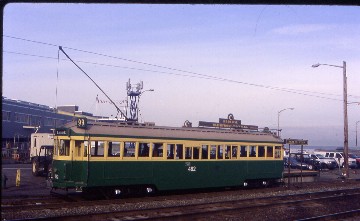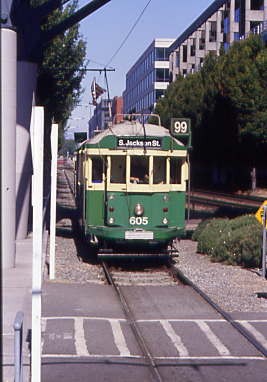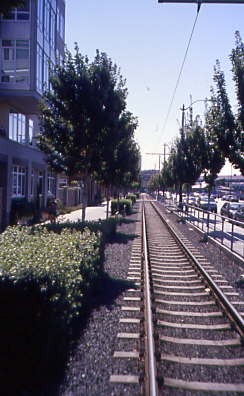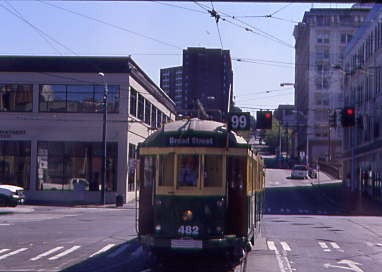I had my first opportunity to ride this line in June 2002 and again in May 2004. While I did not take any pictures, my recollection of my rides were they were a lot of fun and gave one a different perspective of the Seattle waterfront than found when driving. Their Australian heritage appealed to me as well. I was very disappointed when the service ended and vowed to never visit the Seattle Art Museum or Sculpture Park when the park was created. Seattle lost a vital tourist attraction and transportation jewel when the service ended. I was glad that two of the cars went to St. Louis, Missouri, for their Delmar Loop Railway but was unhappy to learn that low ridership caused the operation to fold in December 2019.
Seattle Waterfront Streetcar History
The Waterfront Streetcar, officially the George Benson Waterfront Streetcar Line, was a heritage streetcar line run by King County Metro in Seattle, Washington. It travelled for 1.6 miles along Alaskan Way on the City's waterfront facing Elliott Bay, under the Alaskan Way Viaduct. The Waterfront Streetcar used a fleet of five W2 trams from Melbourne, Australia.
Service began on May 29th, 1982, the first streetcars to run in Seattle since the closure of the Seattle Municipal Street Railway on April 13th, 1941. It initially terminated at Occidental Park in Pioneer Square until the line was extended to International District/Chinatown station in 1990. Service was officially suspended on November 18th, 2005, when the maintenance barn and Broad Street station were demolished to make room for the Seattle Art Museum's Olympic Sculpture Park. A large portion of the trackage and four stations were demolished in 2012 as part of the reconstruction of Alaskan Way.
Streetcar service was replaced by King County Metro Route 99, which operated along Alaskan Way until February 2011 when construction forced Metro to reroute the line to 1st Avenue. King County Metro announced in January 2016 that a private venture would launch a fundraising effort to retrofit two of the historic Waterfront Streetcar vehicles to run alongside modern Seattle Streetcar vehicles on the Center City Connector along 1st Avenue.
City Councilor George Benson (1919-2004) first proposed the idea of building a streetcar line along the Seattle waterfront in 1974, to be operational in time for the national Bicentennial on July 4 , 1976. The line would use vintage streetcars and the goal was to create an attraction that would bring tourists and local residents to the waterfront to help rejuvenate the area, which had already begun a slow transition from a purely industrial district to one with shops and cultural attractions such as the (then-planned, later built) Seattle Aquarium. Eventually, the proposal garnered enough support from the public and Benson's fellow council members that funds were allocated for an engineering and design study, ultimately leading to the approval of the project.
The line used previously existing freight railroad tracks adjacent to Alaskan Way, and construction for the streetcar project involved adding overhead trolley wires, high-platform stations, and a passing track near the middle of the line, which otherwise was single-track. The line started just north of Broad Street, near Pier 70, and until 1990 ran only as far south as Main Street, terminating at a station next to Alaskan Way immediately south of Main Street.
Service began on May 29th, 1982, which was the first streetcar run in Seattle since April 13th, 1941. The first three streetcars had been brought to Seattle from Melbourne, Australia in 1978. They had been Melbourne and Metropolitan Tramways Board cars 482, 512 and 518, and they kept those numbers in Seattle. Two more Melbourne streetcars were acquired between 1990 and 1993. All were W2-class trams that had originally been built between 1925 and 1930.
In 1989, construction began on a quarter-mile extension of the streetcar along Main Street and 5th Avenue to Jackson Street, to connect to the International District/Chinatown Station of the then-new Downtown Seattle Transit Tunnel. The extension opened for regular service on June 23rd, 1990. The line's fourth ex-Melbourne streetcar, No. 272, entered service earlier that month. A fifth car of the same type, No. 605, entered service on June 1st, 1993. Nine years to the day later, King County Council approved legislation to rename the line in honour of Councillor Benson, christening it the "George Benson Waterfront Streetcar Line". The streetcar stations were rebranded and repainted in August 2003.
The streetcar ceased operation on November 18th, 2005, when the maintenance barn was demolished to make room for the Seattle Art Museum's Olympic Sculpture Park. A new maintenance barn was proposed to be built at Occidental Park to allow the resumption of operations as early as summer 2007. However, Metro cancelled involvement after delays made the new facility unlikely to be completed before the demolition of the Alaskan Way Viaduct began. An alternative proposal by the Port of Seattle was to extend the line northward along Myrtle Edwards Park to Smith Cove, where a new maintenance barn would be built on Port property. This proposal was not pursued.
In 2007, two years into the suspension of service, the route was named by National Geographic Society as one of the 10 Great Streetcar routes.
In spring 2012, a large portion of the trackage and the stations at Pike, University, Madison and Washington streets were demolished in as a part of the construction project drilling a deep bore tunnel to replace the Alaskan Way Viaduct.
The City of Seattle began studying the possibility of bringing streetcars back to the city center in late 2012. The locally preferred alternative for this project adopted in late 2014 supported a route along 1st Avenue and not Alaskan Way. James Corner Field Operations, the Manhattan-based andscape-architecture firm hired to recommend a new vision for the Seattle waterfront once the Viaduct has been demolished, also recommended the Streetcar not be returned to Alaskan Way, but to nearby First Avenue instead.
While future plans for the line were determined, the streetcars were stored in an old warehouse in SoDo for more than a decade. In 2015, the Federal Transit Administration informed King County that if the streetcars are not put back in service soon, Metro would need to pay $205,000 to compensate the agency for its remaining investment in the cars. At the same time, the warehouse used to store the streetcars was in poor condition and the land needed for expansion of a neighboring bus base.
In January 2016, it was announced that a private venture, Friends of the Benson Trolleys, was intending to raise the money required to retrofit two of the streetcars to allow them to be used on the future Center City Connector on 1st Avenue. The plan closely mirrors one suggested in May 2009 by then Seattle Mayor, Greg Nickels. The remaining three cars were sold by King County to St. Louis, for use on their planned heritage Delmar Loop Trolley, for which they will need several modifications before they can be used; only one car is being retrofitted (by Gomaco) for service in St. Louis initially. The specific cars sold to St. Louis were Nos. 482, 512, and 518, and they left Seattle in early June 2016. The streetcars retained by King County Metro are Nos. 272 and 605 (along with 525, which never entered service, and has been kept only as a source of parts). Because the warehouse in which they had been stored since the end of Waterfront Streetcar service in 2005 was due to be torn down, to make way for expansion of a Metro bus garage, the streetcars were moved out in early June 2016, to a private site in Arlington, Washington, where they will be stored indefinitely, awaiting possible future developments in the proposals for their return to service.
The line began at the Broad Street maintenance barn and mostly ran along the east side of Alaskan Way on Burlington Northern and Santa Fe Railway trackage under the Alaskan Way Viaduct. Its southernmost section in Pioneer Square consisted of an east–west track on South Main Street that passed Occidental Square and turned south onto 5th Avenue South. It terminated at South Jackson Street, across the street from International District station in the Downtown Seattle Transit Tunnel.
All of the stations (with the exception of the Occidental Park and Jackson Street stations) along the Alaskan Way were originally painted brown when the line first opened. In 2004, all of these stations were refurbished and repainted in Marine Blue. The Occidental and Jackson stations were designed to reflect the surrounding architecture along the streets when the line was extended in 1990. The Jackson Street stop featured an Asian Pagoda-style station while Occidental park had a vintage- style station.
Seattle Waterfront Trolley 482 at Broad Street station on November 11th, 1985. Photograph by Jim Booth.
Trolley 482 at one of the stations. Date unknown.
Broadside view of Trolley 482 at Broad Street station. Date unknown.
The waterfront trolley and a Burlington Northern freight train pass on Alaskan Way. Date unknown.
Trolley 518 making its way along Alaskan Way. Date unknown.
Trolley 482 along the route. Date unknown.
At the passing siding. This photograph and the next four by Chris Guenzler.

Streetcar 482 along the waterfront.

Streetcar 605 approaching Washington Street station.

A view looking south down the route.

The south end of the route at Jackson Street station.
I wish I had more of a photographic record of the Seattle Waterfront Trolley, but alas, I do not. Had it still been operating when I moved to Washington in 2009, I would have a more thorough assortment of pictures.
| RETURN TO THE MAIN PAGE |